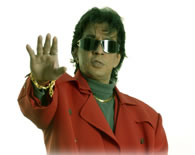
Virender Sehwag smashed the fastest recorded triple century in history as India gave South Africa a dose of their own medicine in the first cricket Test here on Friday.
Sehwag hit 309 not out off 292 balls as the hosts made light of South Africa's daunting first innings 540 to pile up 468-1 by stumps on the third day at the Chidambaram stadium.
When he reached 300 off 278 deliveries, Sehwag surpassed the previous fastest recorded triple ton from 362 balls by Australian Matthew Hayden against Zimbabwe in Perth in 2003-2004.
Only 19 of the 22 triple centuries in Test history have the number of balls faced recorded against them. Those that miss out are Garfield Sobers's 365 not out, Wally Hammond's unbeaten 336 and Hanif Mohammad's 337.
Sehwag hit 42 boundaries and five sixes in the second triple century of his career, having made 309 against Pakistan in Multan in 2004. No other Indian has achieved the feat even once.
The 29-year-old Delhi opener joins Australian legend Don Bradman and West Indian Brian Lara as the only batsmen to have crossed the 300-run mark twice in their Test careers.
Sehwag, who has four 200-plus scores in his 14 Test centuries, is well-placed to go after the retired Lara's record individual score of 400 not out when he resumes on Saturday.
With just 11 wickets having fallen in three days on a barren pitch that is proving to be a bowlers' nightmare, a draw would appear the most likely result in the first match of the three-Test series.
But South Africa will still need to battle the Indian spinners on the wearing turf in their second innings if India, who trail by just 72 runs, manage to gain a useful lead.
Sehwag put on 213 for the first wicket with Wasim Jaffer (73) and 255 for the unbroken second with Rahul Dravid, whose returned unbeaten on 65.
Dravid, who took his career tally to 9,985 runs by stumps, needs only 15 more to become the sixth batsman in history to complete 10,000 Test runs.
Sehwag's double ton off 194 balls was the third fastest in Test history after New Zealander Nathan Astle's 153-ball effort against England at Christchurch in 2001 and Sehwag's own 182-ball innings against Pakistan in Lahore in 2006.
The 55-Test veteran was at his best in the afternoon session when he scored 108 of India's 133 runs after lunch as the South African bowling wilted under the assault in oppressively hot and humid weather.
It was Sehwag's second successive three-figure knock following a match-saving 151 in his last innings against Australia at Adelaide in January.
There was no assistance for the South African bowlers on the slow wicket which allowed the batsmen to play their strokes without fear.
Sehwag moved to 99 with a lofted on-drive off Jacques Kallis and reached his hundred with another skier over the bowler's head in the same over.
He also reached his double century in style, pulling Makhaya Ntini over the square-leg fence for six to move to 199 before taking three runs to long-on off the next delivery.
He hit two other sixes off the hapless Ntini, an audacious slash over third man on Thursday evening and a drive over the covers soon after he had passed his double century.
He crossed his triple century in style and scored 319 runs, the highest b any indian test cricketer.... this shows his guts and destiny.... he is surely a cricket legend in the making!!!!!1111









